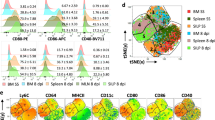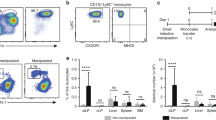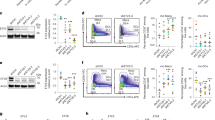Abstract
Monocytes can give rise to either antigen presenting dendritic cells (DCs) or scavenging macrophages. This differentiation is initiated when monocytes cross the endothelium. But the regulation of DC and macrophage differentiation in tissues remains elusive. When stimulated with granulocyte–macrophage colony-stimulating factor (GM-CSF) and interleukin-4 (IL-4), monocytes yield DCs. However, we show here that the addition of fibroblasts switches differentiation to macrophages. On contact with monocytes, fibroblasts release IL-6, which up-regulates the expression of functional M-CSF receptors on monocytes. This allows the monocytes to consume their autocrine M-CSF. Thus, the interplay between IL-6 and M-CSF switches monocyte differentiation to macrophages rather than DCs, and IL-6 is an essential factor in the molecular control of antigen presenting cell development.
This is a preview of subscription content, access via your institution
Access options
Subscribe to this journal
Receive 12 print issues and online access
$209.00 per year
only $17.42 per issue
Buy this article
- Purchase on Springer Link
- Instant access to full article PDF
Prices may be subject to local taxes which are calculated during checkout






Similar content being viewed by others
References
Steinman, R. M. The dendritic cell system and its role in immunogenicity. Annu. Rev. Immunol. 9, 271–296 (1991).
Banchereau, J. & Steinman, R. M. Dendritic cells and the control of immunity. Nature 392, 245–252 (1998).
Banchereau, J. et al. Immunobiology of dendritic cells. Ann. Rev. Immunol. 8, 767–811 (2000).
Becker, S., Warren, M. K. & Haskill, S. Colony-stimulating factor-induced monocyte survival and differentiation into macrophages in serum-free cultures. J. Immunol. 139, 3703–3709 (1987).
Romani, N. et al. Proliferating dendritic cell progenitors in human blood. J. Exp. Med. 180, 83–93 (1994).
Sallusto, F. & Lanzavecchia, A. Efficient presentation of soluble antigen by cultured human dendritic cells is maintained by granulocyte/macrophage colony-stimulating factor plus interleukin 4 and downregulated by tumor necrosis factor α. J. Exp. Med. 179, 1109–1118 (1994).
Zhou, L. J. & Tedder, T. F. CD14+ blood monocytes can differentiate into functionally mature CD83+ dendritic cells. Proc. Natl Acad. Sci. USA 93, 2588–2592 (1996).
Palucka, K. A., Taquet, N., Sanchez-Chapuis, F. & Gluckman, J. C. Dendritic cells as the terminal stage of monocyte differentiation. J. Immunol. 160, 4587–4595 (1998).
Randolph, G. J., Beaulieu, S., Lebecque, S., Steinman, R. M. & Muller, W. A. Differentiation of monocytes into dendritic cells in a model of transendothelial trafficking. Science 282, 480–483 (1998).
Mekori, Y. A. & Metcalfe, D. D. Mast cells in innate immunity. Immunol. Rev. 173, 131–140 (2000).
Yamasaki, K. et al. Cloning and expression of the human interleukin-6 (BSF-2/IFN-β2) receptor. Science 241, 825–828 (1988).
Hibi, M. et al. Molecular cloning and expression of an IL-6 signal transducer, gp130. Cell. 63, 1149–1157 (1990).
Peters, M. et al. The function of the soluble interleukin 6 (IL-6) receptor in vivo: sensitization of human soluble IL-6 receptor transgenic mice towards IL-6 and prolongation of the half-life of IL-6. J. Exp. Med. 183, 1399–1406 (1996).
Menetrier-Caux, C. et al. Inhibition of the differentiation of dendritic cells from CD34+ progenitors by tumor cells: role of interleukin-6 and macrophage colony-stimulating factor. Blood 92, 4778–4791 (1998).
Mitani, H. et al. Activity of interleukin 6 in the differentiation of monocytes to macrophages and dendritic cells. Br. J. Haematol. 109, 288–295 (2000).
Kopf, M. et al. Impaired immune and acute-phase responses in interleukin-6-deficient mice. Nature 368, 339–342 (1994).
Ladel, C.H. et al. Lethal tuberculosis in interleukin-6-deficient mutant mice. Infect. Immun. 65, 4843–4849 (1997).
Tanaka, T. et al. Targeted disruption of the NF-IL6 gene disclosed its essential role in bacteria killing and tumor cytotoxicity by macrophages. Cell 80, 353–361 (1995).
Acknowledgements
We thank E. Kraus and C. Dantin for technical help, and B. Pulendran and V. Pascual for reading the manuscript. Supported by grants from NIH CA-78846-01A1 and Baylor Health Care Systems Foundation.
Author information
Authors and Affiliations
Corresponding authors
Rights and permissions
About this article
Cite this article
Chomarat, P., Banchereau, J., Davoust, J. et al. IL-6 switches the differentiation of monocytes from dendritic cells to macrophages. Nat Immunol 1, 510–514 (2000). https://doi.org/10.1038/82763
Received:
Accepted:
Issue Date:
DOI: https://doi.org/10.1038/82763
This article is cited by
-
Monocyte, neutrophil, and whole blood transcriptome dynamics following ischemic stroke
BMC Medicine (2023)
-
Spatial analysis of stromal signatures identifies invasive front carcinoma-associated fibroblasts as suppressors of anti-tumor immune response in esophageal cancer
Journal of Experimental & Clinical Cancer Research (2023)
-
Galantamine attenuates autoinflammation in a mouse model of familial mediterranean fever
Molecular Medicine (2022)
-
IL-6 promotes low concentration of RANKL-induced osteoclastic differentiation by mouse BMMs through trans-signaling pathway
Journal of Molecular Histology (2022)
-
Learned lesson from COVID-19: can routine immunizations be the first line of defense against the next pandemic?
Egyptian Pediatric Association Gazette (2022)



